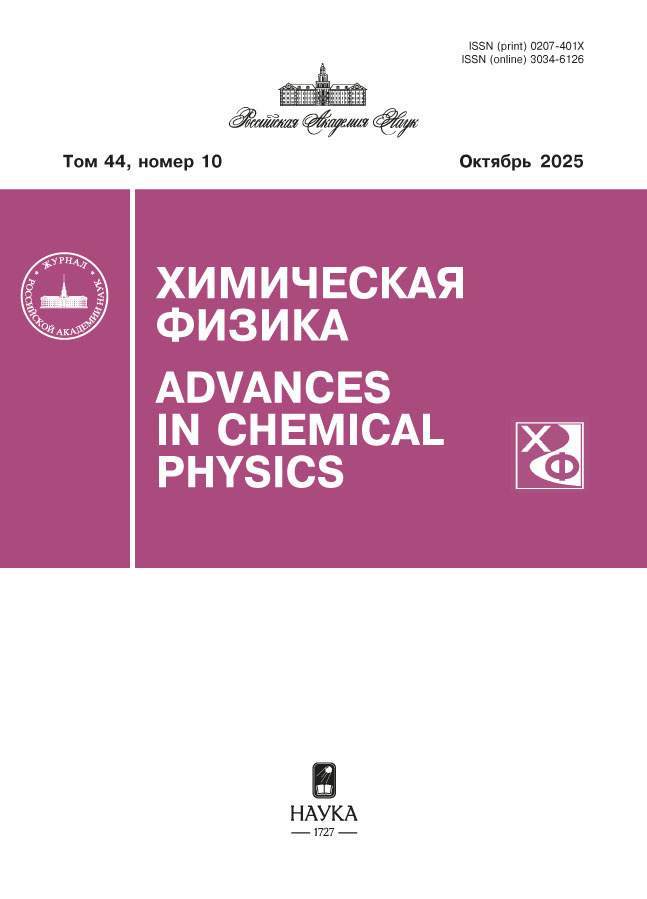Kinetics of thermal decomposition of polymethylmethacrylate in an oxidizing environment
- Authors: Salgansky E.A.1, Salganskaya M.V.1, Glushkov D.O.2
-
Affiliations:
- Federal Research Center of Problems of Chemical Physics and Medicinal Chemistry, Russian Academy of Science
- National Research Tomsk Polytechnic University
- Issue: Vol 43, No 7 (2024)
- Pages: 10-16
- Section: Kinetics and mechanism of chemical reactions, catalysis
- URL: https://cardiosomatics.orscience.ru/0207-401X/article/view/674921
- DOI: https://doi.org/10.31857/S0207401X24070025
- ID: 674921
Cite item
Abstract
Using thermogravimetric analysis (TGA), the kinetic constants of the thermal decomposition of polymethylmethacrylate (PMMA) in an oxidizing environment were determined over a wide range of sample heating rates. The values of the kinetic constants of polymer decomposition were determined by the Kissinger method. It is shown that as the degree of polymer decomposition increases, the rate constant decreases at a constant temperature.
Keywords
Full Text
About the authors
E. A. Salgansky
Federal Research Center of Problems of Chemical Physics and Medicinal Chemistry, Russian Academy of Science
Author for correspondence.
Email: sea@icp.ac.ru
Russian Federation, Chernogolovka
M. V. Salganskaya
Federal Research Center of Problems of Chemical Physics and Medicinal Chemistry, Russian Academy of Science
Email: sea@icp.ac.ru
Russian Federation, Chernogolovka
D. O. Glushkov
National Research Tomsk Polytechnic University
Email: sea@icp.ac.ru
Russian Federation, Tomsk
References
- M.K. Eriksen, J.D. Christiansen, A.E. Daugaard, et al., Waste Manag. 96, 75 (2019). https://doi.org/10.1016/j.wasman.2019.07.005
- G.X. Xi, S.L. Song and Q. Liu, Thermochim. Acta 435 (1), 64 (2005). https://doi.org/10.1016/j.tca.2005.05.005
- M.V. Salganskaya, A.Yu. Zaichenko, D.N. Podlesniy, et al., Acta Astronaut. 204, 682 (2023). https://doi.org/10.1016/j.actaastro.2022.08.039
- E.A. Salgansky and N.A. Lutsenko, Aerosp. Sci. Technol. 109, 106420 (2021). https://doi.org/10.1016/j.ast.2020.106420
- A.D. Pomogailo, A.S. Rozenberg and G.I. Dzhardimalieva, Russ. Chem. Rev. 80 (3), 257 (2011). https://doi.org/10.1070/RC2011v080n03ABEH004079
- E.A. Salganskii, V.P. Fursov, S.V. Glazov, et al., Combust. Explos. Shock Waves. 39 (1), 37 (2003). https://doi.org/10.1023/A:1022193117840
- E.A. Salganskii, V.P. Fursov, S.V. Glazov, et al., Combust. Explos. Shock Waves. 42, 55 (2006). https://doi.org/10.1007/s10573-006-0007-9
- V.N. Mikhalkin, S.I. Sumskoy, A.M. Tereza, et al., Russ. J. Phys. Chem. B. 16 (3), 318 (2022). https://doi.org/10.31857/S0207401X2208009X
- B.P. Yur’ev and V.A. Dudko, Russ. J. Phys. Chem. B. 16 (1), 31 (2022). https://doi.org/10.1134/S1990793122010171
- A.M. Tereza, P.V. Kozlov, G.Ya. Gerasimov, et al., Acta Astronaut. 204, 705 (2023). https://doi.org/10.1016/j.actaastro.2022.11.001
- V.M. Gol’dberg, S.M. Lomakin, A.V. Todinova, et al., Russ. Chem. Bull. 59 (4), 806 (2010). https://doi.org/10.1007/s11172-010-0165-5
- M. Sieradzka, A. Mlonka-Mędrala and A. Magdziarz, Fuel. 330, 125566 (2022). https://doi.org/10.1016/j.fuel.2022.125566
- A.V. Zhuikov and D.O. Glushkov, Solid Fuel Chem. 56 (5), 353 (2022). https://doi.org/10.31857/S0023117722050115
- G.M. Nazin, V.V. Dubikhin, A.I. Kazakov, et al., Russ. J. Phys. Chem. B. 16 (1), 72 (2022). https://doi.org/10.1134/S1990793122010122
- H. Shen, H. Qiao and H. Zhang, Chem. Eng. J. 450, 137905 (2022). https://doi.org/10.1016/j.cej.2022.137905
- C.F. Ramirez-Gutierrez, I.A. Lujan-Cabrera, L.D. Valencia-Molina, et al., Mater. Today Commun. 33, 104188 (2022). https://doi.org/10.1016/j.mtcomm.2022.104188
- G. Lopez, M. Artetxe, M. Amutio, et al., Chem. Eng. Process. 49 (10), 1089 (2010). https://doi.org/10.1016/j.cep.2010.08.002
- W. Kaminsky, M. Predel and A. Sadiki, Polym. Degrad. Stab. 85 (3), 1045 (2004). https://doi.org/10.1016/j.polymdegradstab.2003.05.002
- R.S. Braido, L.E.P. Borges and J.C. Pinto, J. Anal. Appl. Pyrol. 132, 47 (2018). https://doi.org/10.1016/j.jaap.2018.03.017
- M. Ferriol, A. Gentilhomme, M. Cochez, et al., Polym. Degrad. Stab. 79 (2), 271 (2003). https://doi.org/10.1016/S0141-3910(02)00291-4
- B.J. Holland and J.N. Hay, Polymer. 42, 4825 (2001). https://doi.org/10.1016/S0032-3861(00)00923-X
- B.J. Holland and J.N. Hay, Thermochim. Acta. 388, 253 (2002). https://doi.org/10.1016/S0040-6031(02)00034-5
- A.Yu. Snegirev, V.A. Talalov, V.V. Stepanov, et al., Polym. Degrad. Stab. 137, 151 (2017). https://doi.org/10.1016/j.polymdegradstab.2017.01.008
- A. Bhargava, P. Hees and B. Andersson, Polym. Degrad. Stab. 129, 199 (2016). https://doi.org/10.1016/j.polymdegradstab.2016.04.016
- B.L. Denq, W.Y. Chiu and K.F. Lin, J. Appl. Polym. Sci. 66, 1855 (1997). https://doi.org/10.1002/(SICI)1097-4628(19971205)66:10<1855::AID-APP3>3.0.CO;2-M
- K. Miura and T. Maki, Energy Fuels. 12 (5), 864 (1998). https://doi.org/10.1021/ef970212q
- J. Zhang, Z. Wang, R. Zhao, et al., Energies. 13, 3313 (2020). https://doi.org/10.3390/en13133313
- J. Zhang, T. Chen, J. Wu, et al., RSC Advances. 4, 17513 (2014). https://doi.org/ 10.1039/c4ra01445f
- S. Vyazovkin, Molecules. 25, 2813 (2020). https://doi.org/10.3390/molecules25122813
- T. Fateh, F. Richard, T. Rogaume, et al., J. Anal. Appl. Pyrolysis. 120, 423 (2016). https://doi.org/10.1016/j.jaap.2016.06.014
Supplementary files














